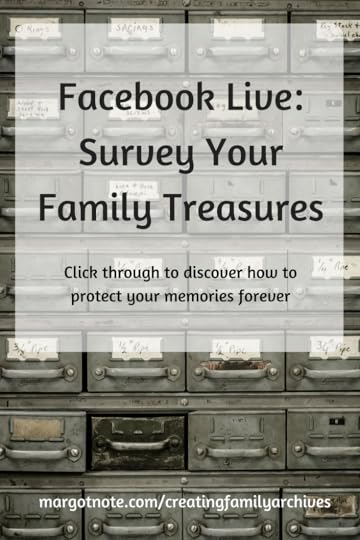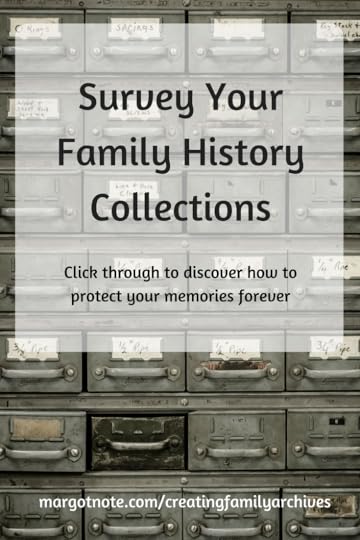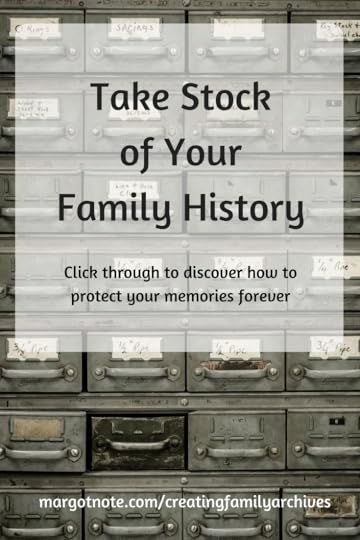Margot Note's Blog, page 48
September 7, 2017
Facebook Live: Preserve Your Photos
Join me this Sunday, September 10th at 9 pm EST via Facebook Live on my Creating Family Archives group page. If you're not already a member, come join the fun!
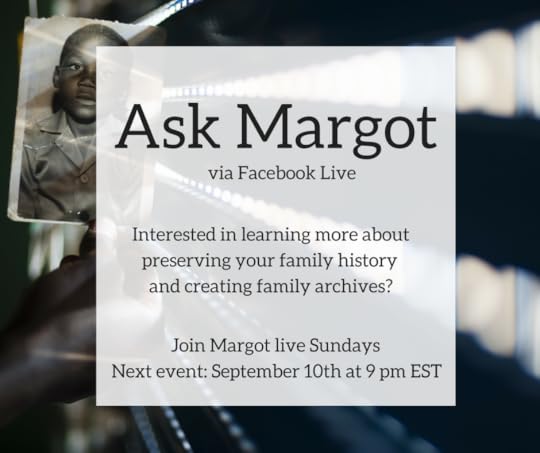
All you need to do to join me is click this link and watch the video on Facebook at 9 pm EST. (Don't live in the Eastern time zone? Convert your time zone here).
In this session, we'll focus exclusively on one of my favorite things--photographs! Photographs are the treasures of any family history collection. They allow us to see firsthand the same eyes or smiles we inherited from our forbearers. Preserving your photos for the next generation is well worth the time you invest in the effort.
To participate, please join my group, Creating Family Archives here: https://www.facebook.com/groups/CreatingFamilyArchives/
To learn the preservation secrets used by libraries, archives, and museums to protect their priceless materials (that you can also use for your family heritage items) read my book:
amazon Block
Search for an Amazon product to display.
Learn more.
Like this post? Never miss an update when you sign up for my newsletter:
Follow me on Pinterest | Instagram | Twitter | LinkedIn | Facebook

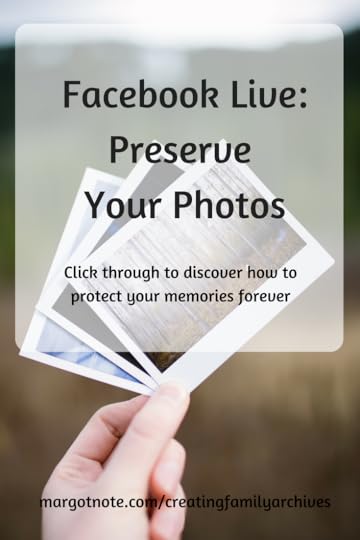

September 5, 2017
9 Reading Strategies for Better Comprehension
There are a variety of reading methods that can help you take in more information, make your efforts more efficient, and save time. A professor in graduate school once told me that students are never expected to complete all the readings; instead, they learn how to prioritize their reading so that they can get the essence of the texts.
Learning that took the pressure off of me to read my texts from cover to cover. I aimed my attention at the parts of the books and articles that would serve me best as a student. With this plan in mind, I found that my retention of knowledge increased and my stress was reduced.
Here are some strategies for reading:
Purpose-LedHaving a purpose for reading is one of the main reading strategies. If you know what information you are looking for in the text, it is easier for you to stay focused. The purpose for reading can vary. It may include finding answers to specific questions, getting an overview, writing a summary, or refreshing your memory of a text or book that was studied in class.
PredictingPredicting means looking at the title, subtitle, visuals, and section titles of a text or chapter and guessing the content. For review, this step can be used to check what can be remembered from the material. Later, you can read the text actively and see whether your predictions were accurate.
OverviewingGetting an overview of a complex text, before reading it in detail, helps to build up a mental outline of the main ideas covered. Read the introduction and conclusion, as well as the first and last sentences of each paragraph. This process allows you to see the bigger picture of the text.
SkimmingSkimming means quick reading—faster than your normal reading speed. The aim is to take in chunks of information and make connections between sections. It is especially useful for the review of texts that have already been read at least once.
ScanningScanning is not really reading. Instead, it involves moving very fast through a text to find a specific piece of information, such as a key phrase, name, or number. This strategy is mostly used when searching for answers to specific questions.
SelectingSelective reading is the process of choosing what to read within a whole text or chapter. Depending on the purpose, you can select specific sections, containing answers to questions or topic-specific details, that need to be reviewed. This strategy is best combined with getting an overview to identify the relevant details.
StrategizingStrategize your reading. Always focus on the core readings. For supplemental readings, focus on readings that make an argument first. Then move on to readings that describe an event or person. Lastly, look at readings that only provide context.
Active ReadingActive reading is a five step process, described in Zachary Shore’s Grad School Essentials: A Crash Course in Scholarly Skills. It’s used to locate and assess the author’s question, thesis, and key evidence. First, analyze the title and subtitle, then scrutinize the table of contents. Read the last section first, looking for the summary of the argument, then read the introduction. Lastly, target the most relevant chapters of the book, or sections of the article.
Post-reviewingReading reviews of the book can help highlight key ideas in the text, especially if the book is well-known or part of the canon of your field. You can try one of the strategies above, then read reviews of the book when it was published (as well as subsequent editions) to see how the book was received over time. Reviews can bring out the major themes of the book, and while review will never replace the act of reading the primary document, it can help provide context.
No matter what strategy you use, keep in mind that reading for work or school should always serve an objective. Save your careful reading for the books you read for pleasure so that you can luxuriate in them and unwind.
Interested in what I'm reading for fun or function? Become my friend on Goodreads.
Follow me on Pinterest | Instagram | Twitter | LinkedIn |
Like this post? Never miss an update when you sign up for my newsletter.
August 31, 2017
Facebook Live: Preserve Your Papers
Join me this Sunday, September 3rd at 9 pm EST via Facebook Live on my Creating Family Archives group page. If you're not already a member, come join the fun!
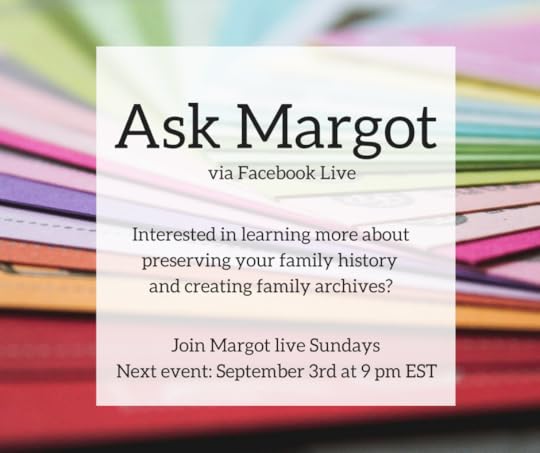
All you need to do to join me is click this link and watch the video on Facebook at 9 pm EST. (Don't live in the Eastern time zone? Convert your time zone here).
Family documents are among the most valuable heirlooms in any archives. These papers can provide new information or verify family legends about births, deaths, and marriages. Historians love documents for the details they reveal about relationships and everyday life. In this session, we'll focus exclusively on the preservation needs of your paper-based documents.
To participate, please join my group, Creating Family Archives here: https://www.facebook.com/groups/CreatingFamilyArchives/
To learn the preservation secrets used by libraries, archives, and museums to protect their priceless materials (that you can also use for your family heritage items) read my book:
Creating Family Archives: How to Preserve Your Papers and Photographs
By Margot Note
Like this post? Never miss an update when you sign up for my newsletter:
Follow me on Pinterest | Instagram | Twitter | LinkedIn | Facebook

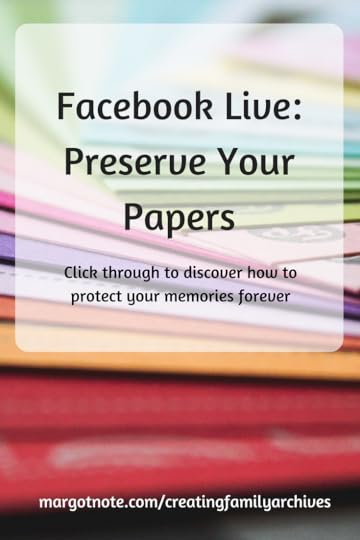

August 29, 2017
Strategies for Better Note-Taking
Note-taking for classes, meetings, studying, or research is a skill you develop over time. Use any note-taking style that works best for you. Experience with different formats, combine them, or improvise to create your style.
As a student, I was always a good note-taker. I had to live up to my last name, of course! Over time, I developed systems to help me document meetings, share ideas, and write books and articles.
Here are some strategies to improve your note-taking habits:
Try note-taking templates available in stores or online. Investigate systems like Cornell Notes or Smart Wisdom, for example. Experiment to see if prefer to write or type your notes.Make key points stand out.Circle, underline, or color-code key words and ideas.Make notes more concise by leaving out unessential words and by using abbreviations, arrows, and symbols.Show how ideas are connected, such as by using the mind map style.Organize notes using boxes, arrows, exclamation marks, and other symbols.Use colors, highlighters, and visuals, if helpful.Compare your notes with others studying the same subject; they may have captured information that you haven’t.Write as if you were capturing information for a friend unfamiliar with your topic. How can you explain the information clearly for future reference? When I was an undergraduate, I earned money taking notes in class for students with learning disabilities. Because I was taking notes for someone else, I made sure to be as clear as possible.Take notes twice. For example, I write down everything I can capture on the fly for business calls. I later transfer these notes, neatly and better organized, into my business notebook for posterity.Keep practicing. Note-taking is a skill that requires regular development.
Follow me on Pinterest | Instagram | Twitter | LinkedIn |
Like this post? Never miss an update when you sign up for my newsletter.
August 23, 2017
Facebook Live: Processing Your Family History Collections
Join me this Sunday, August 27th at 9 pm EST via Facebook Live on my Creating Family Archives group page. If you're not already a member, come join the fun!
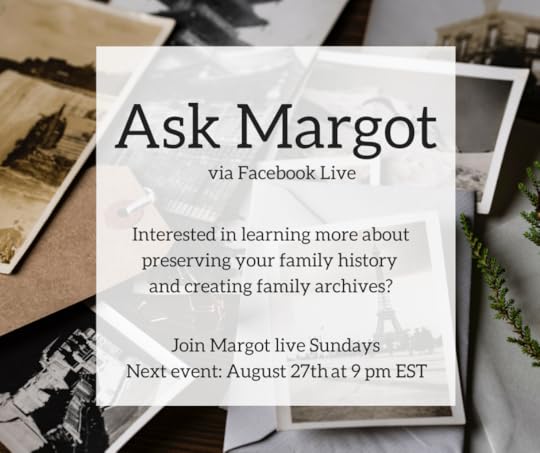
Please note the new day and time (Sundays at 9 pm EST). I'm experimenting with a new day and time. I'm also starting a major project that will require me to process and rehouse a writer's archives in a storage facility in the Lower East Side. It's like heaven to me but there's no wifi there!
All you need to do to join me is click this link and watch the video on Facebook at 9 pm EST. (Don't live in the Eastern time zone? Convert your time zone here).
In this session, we'll be discussing how to process your collection. Learn ways to organize your family treasures, perform some initial preservation activities, label your collections properly, and create finding aids.
To participate, please join my group, Creating Family Archives here: https://www.facebook.com/groups/CreatingFamilyArchives/
To learn the preservation secrets used by libraries, archives, and museums to protect their priceless materials (that you can also use for your family heritage items), read my book:
Creating Family Archives: How to Preserve Your Papers and Photographs
By Margot Note
Like this post? Never miss an update when you sign up for my newsletter:
Follow me on Pinterest | Instagram | Twitter | LinkedIn | Facebook
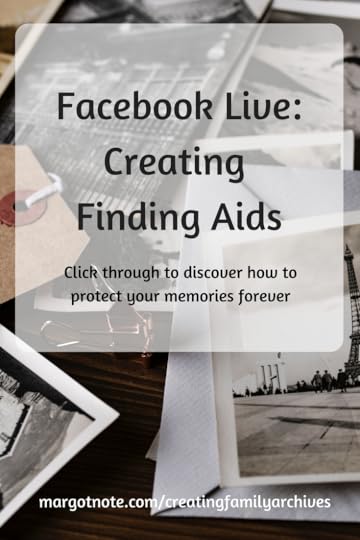
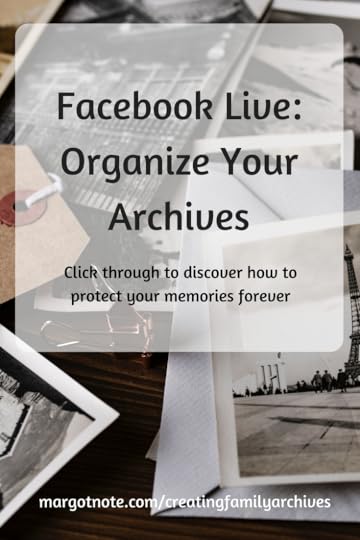
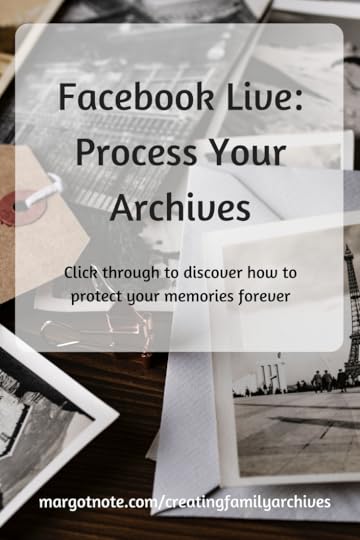
August 17, 2017
Facebook Live: Purchasing Archival Materials
Join me this Monday, August 21st via Facebook Live on my Creating Family Archives group page. If you're not already a member, come join the fun!
Due to a business trip, I'll be filming at a new time and location: 9 pm EST from my mother's house!

All you need to do to join me is click this link and watch the video on Facebook at 9 pm EST. (Don't live in the Eastern time zone? Convert your time zone here).
In this session, we'll be discussing what to look for to rehouse your precious family treasures. The preservation of your collections is significantly advanced with the help of stable enclosures. Once you have your selection of acid-free, lignin-free, pH neutral boxes, folders, tissues, and more, you can ensure the safest storage possible for your most valued items.
To participate, please join my group, Creating Family Archives here: https://www.facebook.com/groups/CreatingFamilyArchives/
To learn the preservation secrets used by libraries, archives, and museums to protect their priceless materials (that you can also use for your family heritage items) read my book:
Creating Family Archives: How to Preserve Your Papers and Photographs
By Margot Note
Like this post? Never miss an update when you sign up for my newsletter:
Follow me on Pinterest | Instagram | Twitter | LinkedIn | Facebook
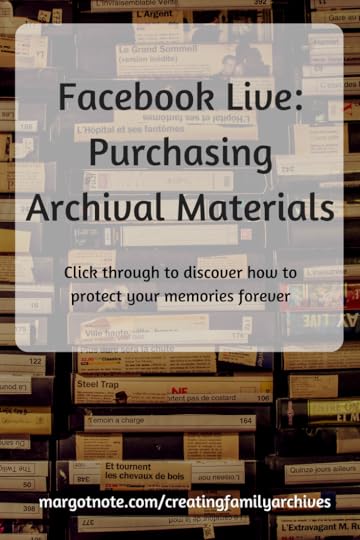


August 15, 2017
8 Secrets to Your Best Academic Performance Ever
I’m an expert in doing well in school.
I was in the top ten academically in high school, and I got As all through my higher education years. I worked full-time during graduate school and while writing my books. I teach a course on Research Methods for graduate students to help them develop skills that will last them through their careers as historians.
I am by no means brilliant. But I am smart enough, work hard, and have developed habits that achieve the best results for me.
I want to share some tips to help you get better grades in less time and with less stress and effort.
A caveat: my suggestions are written primarily for undergraduates in the humanities who attend school in person. Most of what I suggest is transferable to students in high school or graduate school, those who study STEM subjects, and online students.
Befriend a LibrarianI learned at a professional conference recently that a one-hour session with a librarian can save up to nine hours of individual research.
Talk with the staff at your library and develop a rapport with them. People became librarians because they want to help people discover information. Librarians can help in a pinch when you have overdue fines, need a book ordered, or have an obscure research topic.
Before you start a project, talk to a librarian to develop a research plan. A 15-minute conversation will set you on the right path quickly.
At the beginning of the school year, most schools offer bibliographic instruction classes, where a librarian discusses all the sources of information that are available to students. Many classes are in person; some are online. Take advantage of this opportunity before the school year gets underway. The class allows you to see the scope of materials that available to you, so you’ll have a better understanding of where to start your research.
Basic Bitches Use GoogleA client of mine told me that almost half of their academic library’s budget is devoted to database subscriptions. A chunk of your tuition is put towards scholarly databases; if you only use Google for research, you are throwing away money.
It is possible to do good research on Google, but you would already have to be an excellent researcher. All too often, people only use the results that show up on the first page, which are not always the best.
Instead, use the scholarly databases that your library subscribes to which will give you better quality sources such as peer-reviewed articles and better search options.
Depending on your subject, one or two databases may be the ones that will find the best material. Ask a reference librarian which ones would be the best for your project and how to search within them. Each database offers different options and filters to refine your search.
Develop a Study RoutineAs you mature as a scholar, you will discover what study and research options work best for you. For example, I like to write notes by hand and read them to myself to retain the information better. Through trial and error, I’ve found this method works the best for me.
Set the stage for your best work. What do you like to drink as you study? Do you play music or is it quiet? Where do you like to study? What can you do to maintain your concentration? Do you study best in a group or individually? What time of day works for you?
There’s no single best way to study, only one that syncs up best with your learning style and preferences.
Attend Office HoursIf a professor has office hours, stop by. This is especially important for subjects that may not come easily to you.
As a first-year, I took a 7:00 am Calculus class; I still don’t know what I was thinking. I had a hard time understanding some concepts from class, so I visited my professor during his office hours so we could work through my calculations. I received one-on-one attention, and he became more comfortable teaching me. I did better in class, and I imagine I was graded better—as much as there is some wiggle room in grading a math class—because he knew that I was putting in the extra effort.
Teachers teach, so let them. Take advantage of their wisdom. It’s helpful for them to know what you are struggling with, because you are probably not the only one in class who is having that problem.
Visit the Writing CenterEveryone benefits from writing better and having an editor.
If your campus has a writing center, visit it before your next assignment is due. You’ll be able to work one-on-one with another student to refine your paper. They will pick up on ideas that need more clarification and fix the awkward phrasing and grammatical errors that take away from what you’re trying to express.
Many students come to college without the ability to write well, and professors don’t often have the time to copy-edit your writing. Use your time as a student to develop your writing skills; no matter what career you ultimately land in, being a good writer will always help you.
As an undergraduate, I used to work at the campus writing center. A nursing student began meeting with me because she was having difficulty completing her assignments.
For example, when she read her writing out loud, she inserted words that weren’t on the page. She “wrote” perfectly while speaking, but her written communication was choppy. She didn’t see the omissions until I pointed them out.
It wasn’t easy working with her. Sometimes she was frustrated and angry. Who wouldn’t feel uncomfortable when someone is pointing out your errors? I admired her because she kept on working. We discovered ways to improve her writing while still retaining her unique voice.
After a few weeks, she told me that her professors noticed her progress and her grades jumped. She radiated pride. It was all on her; I was just there to facilitate her growth.
Use the Pomodoro TechniqueFrancesco Cirillo invented a time management system called Pomodoro after the tomato-shaped timer he used to track his work as a student. (“Pomodoro” is Italian for “tomato”).
The methodology is simple. When faced with a large task, break the work down into intervals (called “Pomodoros”) which are interrupted by short breaks. This structure trains your brain to focus and rewards it with a pause.
Typically, a Pomodoro is 25 minutes, and a break is 5 minutes. When you are procrastinating, promise yourself you will complete a Pomodoro. You will be amazed at what you can complete during that period, and you may find yourself eager to complete more Pomodoros.
Learn Editing TricksWhen you are nearing completion of your assignment, print it out. Make your edits on paper, and read it out loud. Editing on screen can catch major errors, but editing on paper reveals minor mistakes.
Reading your assignment out loud allows your ears to find errors that your eyes can’t see. You detect awkward phrasing, misused words, and other quirks. I use text-to-speech readers online discover more issues to correct.
Grammarly, Hemmingway App, and Expresso can also be used to fix grammar and style mistakes. Take their suggestions with a grain of salt; not everything they find needs to be changed.
Practice Self-CareMany schools offer health and wellness programs to their students. Seek professional help if you find yourself overwhelmed by stress, anxiety, or physical or mental problems. Develop ways to stretch yourself academically while also spending time relaxing and recharging.
A friend of mine was in a rigorous architecture school, which required endless hours of working, rendering, and studying. Even during the craziest of deadlines, she took a 20-minute walk daily. She needed that short period to clear her mind before she could continue working.
The most important part of becoming a better scholar is to become a better person, holistically. No grade is worth overworking yourself or becoming unbalanced in life.
Follow me on Pinterest | Instagram | Twitter | LinkedIn |
Like this post? Never miss an update when you sign up for my newsletter.
August 10, 2017
Facebook Live: Treasure, Trash, or Transfer Your Family History Items
Archivists cannot save everything. They are forced to make choices. You, too, must decide what items you want to keep and why you want to keep them because you are limited in your money, space, and time. Ask yourself: what would you rather keep: clutter that has deteriorated in improper storage or your most prized heirlooms?
Join me this Monday, August 14th at 2 pm EST via Facebook Live on my Creating Family Archives group page. If you're not already a member, come join the fun!
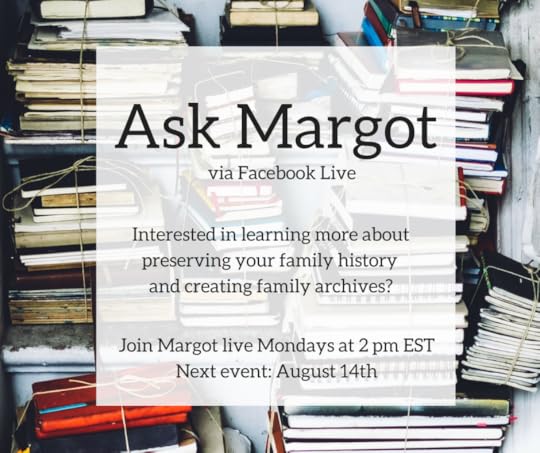
All you need to do to join me is click this link and watch the video on Facebook at 2 pm EST. (Don't live in the Eastern time zone? Convert your time zone here).
In this session, we'll be discussing archival appraisal. Together, we will talk about items in your family's collections that you should keep, throw away, or transfer elsewhere. What remains are only the collections that are the most important to your family's history.
To participate, please join my group, Creating Family Archives here: https://www.facebook.com/groups/CreatingFamilyArchives/
To learn the preservation secrets used by libraries, archives, and museums to protect their priceless materials (that you can also use for your family heritage items) read my book:
Creating Family Archives: How to Preserve Your Papers and Photographs
By Margot Note
Like this post? Never miss an update when you sign up for my newsletter:
Follow me on Pinterest | Instagram | Twitter | LinkedIn | Facebook
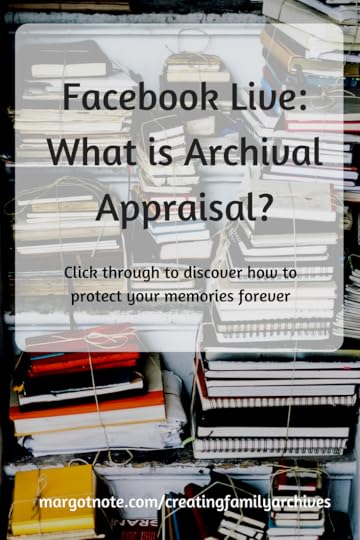


August 8, 2017
An Interview on Genealogy Happy Hour
I was recently interviewed on the Genealogy Happy Hour podcast about my book, Creating Family Archives: How to Preserve Your Papers and Photographs. Considering that I just got back from a red eye flight from Portland, Oregon for the annual conference of the Society of American Archivists, I think I did pretty good!
Genealogy Happy Hour is "a podcast that helps newbie genealogists get started on the right track." Amy Crabill Lay is the owner of Heirs & Ancestors, LLC, a genealogical research company, and Penny Bonawitz, a genealogist. What I enjoy most about the podcast is that it sounds like two friends catching up on their hobby over a couple of glasses of wine; I love the casual, conversational tone.
On Episode 25, Amy and Penny provide tips on archiving your family history, then jump into an interview with me.
(10:45): "Why did you write this book?"
(13:07): "What type of supplies should a family historian use to archive and organize their family history?"
(15:13): I provide a tip on a big box store that has a surprising amount of archival quality supplies, so you can see what acid- and lignin-free boxes and enclosures look like before you purchase them.
(16:24): "What are the pros and cons of photo albums?"
(19:33): "You talk about keeping collections in their original order... so you can learn how someone else has organized materials before you."
(22:35): "How do you determine which items should be kept and which items should be tossed?"
(26:53): "Do you have a system? Do you save just physical files or digital files or a combination of both?"
To learn the preservation secrets used by libraries, archives, and museums to protect their priceless materials (that you can also use for your family heritage items) read my book:
Creating Family Archives: How to Preserve Your Papers and Photographs
By Margot Note
Like this post? Never miss an update when you sign up for my newsletter:
Follow me on Pinterest | Instagram | Twitter | LinkedIn | Facebook

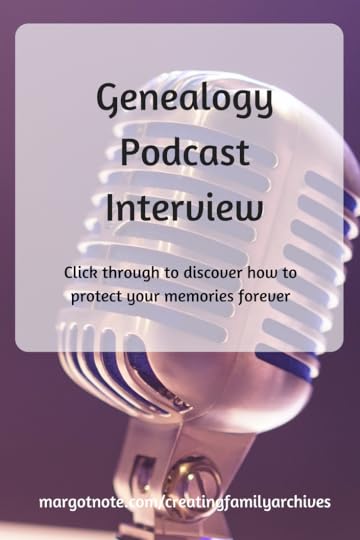

August 3, 2017
Facebook Live: Surveying Your Collections
Take stock of your family history materials before you start your archives project. Join me this Monday, August 7th at 2 pm EST via Facebook Live on my Creating Family Archives group page. If you're not already a member, come join the fun!
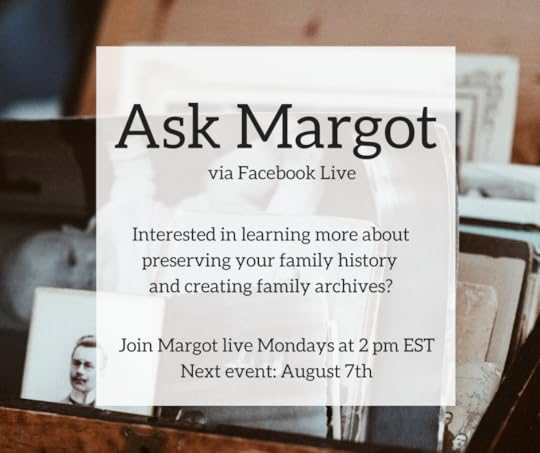
All you need to do to join me is click this link and watch the video on Facebook at 2 pm EST. (Don't live in the Eastern time zone? Convert your time zone here).
We'll be chatting about to take a general inventory of all of your archival materials, so we can reassess our plans and get to work.
To participate, please join my group, Creating Family Archives here: https://www.facebook.com/groups/CreatingFamilyArchives/
The video will be shared on my website for viewing after the live event, so even if you don't have Facebook you won't miss out.
To learn the preservation secrets used by libraries, archives, and museums to protect their priceless materials (that you can also use for your family heritage items) read my book:
Creating Family Archives: How to Preserve Your Papers and Photographs
By Margot Note
Like this post? Never miss an update when you sign up for my newsletter:
Follow me on Pinterest | Instagram | Twitter | LinkedIn | Facebook
